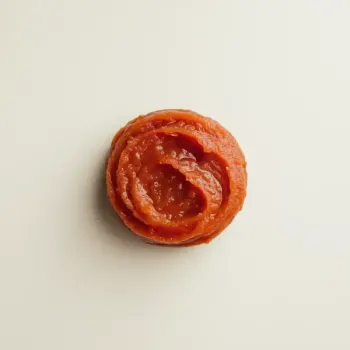Sun-dried tomatoes are dried, intense flavored tomatoes often preserved in oil, while tomato paste is a concentrated tomato puree used as a base in cooking. Both add rich taste to dishes but differ in texture and usage.

Sun-dried tomatoes are ripe tomatoes that have been dried under the sun or through artificial methods to remove most of their water content. They are known for their intense, sweet-tart flavor and chewy texture and are often preserved in olive oil with herbs.

Tomato paste is a thick concentrate made by cooking down tomatoes for several hours to reduce moisture, then straining out the seeds and skins. The resultant product is a deep red, rich paste with a strong tomato flavor, commonly used to enhance the base of sauces and soups.
Sun-dried tomatoes offer a chewy texture and a sweet, robust flavor, whereas tomato paste provides a smooth consistency and a concentrated tomato essence. Sun-dried tomatoes are typically used as a feature ingredient, while tomato paste often serves as a base or background note in dishes.

Your ultimate Recipe Box, Meal Planner, and Cooking Class all in one
Ideal for adding to pasta salads, bruschetta, and frittatas, sun-dried tomatoes impart a burst of Mediterranean flavor. They are best used when you want a chewy texture and a pop of intense tomato taste. Tomato paste is perfect for enriching the flavors of stews, sauces, and marinades in Mediterranean cuisine. Its concentrated nature deepens the overall taste profile of a dish without adding bulk or altering texture.
In pasta dishes like penne alla puttanesca or linguine with sun-dried tomato pesto, sun-dried tomatoes bring a unique tanginess and texture that complements both creamy and oil-based sauces. Tomato paste is a staple in creating a rich and velvety tomato sauce for spaghetti Bolognese or lasagna. It thickens sauces and provides a foundation for the layers of flavor in traditional Italian cooking.
Sun-dried tomatoes can be sprinkled on pizza as a topping, offering a chewy texture and a concentrated burst of flavor that complements cheeses and other toppings. Tomato paste can be used as a base for pizza sauce, providing a thick, rich tomato flavor that evenly coats the dough and supports additional toppings.
Both sun-dried tomatoes and tomato paste are rich in lycopene, an antioxidant, but their nutritional profiles differ due to their form and preparation.
| Nutrient | Tomato Paste ( per 100g ) | Sun-dried Tomatoes ( per 100g ) |
|---|---|---|
| Fat | 0.47g | 2.97g |
| Fiber | 4.1g | 12.3g |
| Sodium | 38mg | 2095mg |
| Protein | 4.32g | 14.1g |
| Calories | 82 | 258 |
| Carbohydrates | 18.91g | 55.76g |
Sun-dried tomatoes can be rehydrated and blended to use as a substitute, but the sauce will have a different texture and a more intense, sweet-tart flavor profile.
Both have health benefits, but tomato paste is lower in calories and sodium. However, sun-dried tomatoes have a higher protein and fiber content.
Yes, they can complement each other with sun-dried tomatoes adding texture and tomato paste providing a smooth base.
Store sun-dried tomatoes in an airtight container, preferably in oil, and keep them in a cool, dry place. Tomato paste should be refrigerated after opening and used within 5-7 days, or it can be frozen for longer storage.
Tomato paste is better for low-moisture dishes as it is more concentrated and has less water content than rehydrated sun-dried tomatoes.